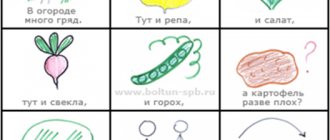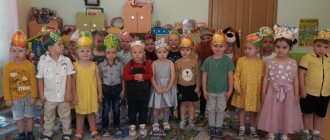Definition
Mnemonics (mnemonics) is a list of methods and techniques that help remember various types of information.
Mnemonics is based on the principle of visualizing abstract objects, which are replaced by specific concepts or figurative definitions. To easily and quickly memorize the necessary information, you need to associatively associate it with some visual idea, sound image or sensation. Associations - establishing connections with known images and phenomena.
Mnemonics for children
Over the past few decades, this innovative direction in pedagogy and speech therapy has become popular. Kindergarten teachers began to pay more attention and time to speech development.
Classes are held in groups where children get acquainted with works of art, poetry, and fairy tales. It is especially useful to memorize poems and read them with expression. This trains memory, shapes speech, and enriches vocabulary.
Expressiveness of performance develops speech technique - diction, breathing. To do this, special exercises are carried out to help develop speech hearing and clear pronunciation of sounds and words. Also, the educational program of the preschool educational institution includes classes on mnemonics.
How to teach a child to remember?
Mnemonics is a technique that makes it easy to remember information. Everyone knows from childhood “ Every Hunter Wants to Know Where the Pheasant Goes ” - the colors - and will be the most common example of mnemonics.
Mnemonics for children - what are the benefits and when to use them?
For schoolchildren and students, the ability to quickly remember a large amount of information is like a super prize in a lottery: reports, poems, essays, speeches at school events, olympiads - it becomes much easier to prepare for them. But besides these obvious advantages, there are also hidden ones:
- Mnemonics are based on associations, so when used, associative thinking develops.
- Mnemonics involves different types of thinking, including logical thinking, as well as imagination.
- Increases vocabulary and coherence of thought.
- Interest in learning appears: when, instead of an hour to memorize the main outline of the text and retell it, the child does it in 10 minutes, it’s hard not to be happy about it.
Mnemonics is based on remembering information through associations, so you can safely start classes from 2-3 years old. Already in kindergarten, a child is able to retell the meaning of “The Ryaba Hen” thanks to pictures - this is one of the techniques: the use of mnemonic tables (pictures). Mnemonic tables are effective for children because at this age their memory is visual: they remember what they see. Therefore, it is difficult with children to learn something that is not visually reinforced. The older the child gets, the more memory methods can be used.
Mnemonics: 3 main ways to memorize
1. Mnemotables. The method is suitable for children and primary schoolchildren, when the amount of information is not as large as in middle school. The method is suitable for literature lessons and working with text, memorizing poems and songs in music lessons, etc. Mnemonic tables are diagrams with symbols (pictures, letters, etc.) located on them, in a certain order. How to work with a child? Start your lessons with fairy tales known to your child. Print out the pictures or take them from a children's book, arrange them in a chaotic order, and ask your child to collect them in the correct sequence. If the child cannot cope, help with leading questions. After this, ask them to retell the plot of the fairy tale, based on the images. Over time, complicate the tasks: longer texts, more intricate plots, it is good for the child to come up with and draw pictures, which will then help him when retelling the text. When memorizing poems, there should be one picture-image for each line. Mnemonic tables are also suitable for memorizing large texts; in this case, the text is divided into a plan and each of its points is given 1 large association picture. This picture may contain the meaning of the entire paragraph.
2. Poems/rhymes. This method is great for learning rules, procedures, etc. Poems themselves are already one of the techniques of mnemonics, which is based not only on association, but also on hearing. Examples from the rules of the Russian language:
We ate cake for a long time. Shorts didn’t fit!
Such techniques are used not only in the Russian language, but are also common in other disciplines, for example, in geometry: A bisector is a rat that runs around the corners and divides the corner in half!
In this method, it is not necessary to use already existing memory rhymes; you can come up with your own.
3. Roman Room Method or Cicero Method. It is generally accepted that Cicero never used any notes during his speeches, and delivered his speech solely from memory. The secret is simple: Cicero, walking around his own house, “attached” the topics of his report to things. This is somewhat reminiscent of an adapted “cross on your hand so as not to forget” method. So, when Cicero spoke, he mentally returned to his house and, using its image and associations, reconstructed the plan of his story. Cicero's method is perfect for schoolchildren when defending essays, reports, or when retelling a historical event or a writer's biography. The bottom line: the child must attach images to a place that is familiar to him. For example, his bedroom or school office. We select 1 wall, look at what is located on it (we go either from top to bottom or from right to left): a bookcase with books, a picture, a board, a pointer, a flower. For each subject in order, we attach the plan of our story (or the material that you want to remember). A cabinet with books - the date of birth and death of the writer, his family - each book is a separate person: mother, father, brother, sister; the picture is the writer’s childhood, etc.
Mnemonics with its methods of memorization are suitable for children and adults; they will help you prepare perfectly for a performance or simply memorize a poem, and will also help increase your memory, vocabulary, and the logic of speech.
Our online classes will also help in developing the memory of preschoolers and primary schoolchildren.
Mnemonic techniques
- Eidotehnika (eido - image) - representation of an object outside the zone of perception, i.e. application of imaginative thinking. The exercise is aimed at creating images, objects, and natural phenomena.
- Associative chain technique . Words are connected in order, one after another, without skipping. The result is a story or fairy tale. In this game, children quickly remember a chain of words.
- The Cicero method is the placement of information in space. The essence of the method is the imaginary placement of images in a specific place.
- Method of transformation (transformation). Exercise promotes the development of memory and logical thinking. The words seem to flow from one another, something unites them.
- Support method (numeric-letter method). Children remember information by associating the meaning of certain words, sounds and numbers.
- “Croqueting” technique (from the French word croquis - drawing, sketch). Method of graphic associations. The essence is to recode the information received when drawing objects and natural phenomena.
Mnemonic table, mnemonic square, mnemonic track, collage - these are the teaching tools of the crocheting method.
Mnemonic tables are images containing information. They reduce learning time and at the same time develop memory, attention, and creative thinking. Help transform abstract images into concrete objects.
A mnemonic square is a card with an image of encoded information.
Mnemonic track is a sequential distribution of mnemonic squares according to which the child composes a story.
Collages are aids that perform the following tasks:
- teach (thematic collages);
- remember;
- form the skill of attention distribution.
Exercises for preschoolers
Preschool age is considered a favorable period for laying the foundations of competent, clear, beautiful speech. Mnemonics for beginners (simple, fun tasks, games) will help your child’s speech develop faster. It is useful for the development of the articulatory apparatus to perform tasks using onomatopoeic words. They correct diction well - pure jokes (“If only there was smoke coming out of the chimney”), nursery rhymes, phrases containing a certain group of sounds (“Sanya’s sleigh rides on its own”).
Exercises on the pronunciation of hissing sounds can be combined thematically.
After looking at the picture “Hedgehog and Hedgehogs,” the adult offers to complete a number of tasks. The child must clearly pronounce phrases with the sounds “sh” and “zh”. “Sha-sha-sha - we walk slowly; shu-shu-shu - I’ll give the baby a raspberry; shi-shi-shi - where the kids walk.” Such exercises help you master question intonation and develop a sense of rhythm.
By isolating the sound while clearly pronouncing a word, the skill of understanding the terminology “sound” and “word” is developed. When working with children, it is necessary to emphasize the development of intonation sense, rate of speech, diction, and strength of voice. Games can help with this.
Exercises for beginners:
- "Whose voice is this ? The goal of the game is for the child to learn to recognize adult animals from young animals by the reproduced sound. For such a game, you can take figurines of a dog and a puppy, a duck and a duckling, a cat and a kitten. Alternatively, you can sculpt animals from plasticine or use cards. The plot of the game: animals come to visit the baby, they want to play with him. Children should understand the difference between how a mother cat meows and how her baby meows.
- Game "Compare the cubes" . The task is to teach the child to correlate objects with different characteristics. An adult offers to look at two cubes and tell how they differ. The kid takes one cube and says that it is big, and the second cube is small. The first cube is red and the second is white. The red cube is plastic, the white cube is made of fabric and is soft inside.
- Game “Compare two kittens” . The child is asked to look at the kittens. One of them is white and large, and the second is black and smaller. You need to say who they are. Come up with names for them so that it is clear that one kitten is black and the other is white. What is the difference.
- Game “What little animals can do . The goal of the game is to choose verbs that denote the characteristic actions of animals. An adult shows pictures of animals, and the child must say what they can do or what they say. For example, a cat loves mice. She loves to meow. The dog loves to bark and eat bones, run and jump. The cockerel crows and loves to peck grains.
- Game "Profession" . Here you will need cards that depict people of different professions (pilot, hairdresser, doctor, cook). An adult asks who heals people. The kid must answer correctly. This is how the remaining cards are played.
- The game “Wizards” helps expand vocabulary, develops long-term memory and logical thinking. You will need cards with images of individual objects - a table, an apple, a door. The adult names several words, and the child must choose those cards that will help him remember the named words. He kind of “bewitches” them into these cards. Then the baby takes the cards and with their help remembers the named words. The game is aimed at understanding the logical connections between objects.
Regular playful activities help to awaken interest in words. The exercises prepare children for further independent compilation of narratives, stories, texts, and form connected speech.
How do preschoolers learn mnemonics?
Teaching the system to preschool children often begins at 4-5 years of age with the simplest techniques.
- A mnemonic square is a card that shows one image, one word or a short phrase. Used from 3-4 years.
- A mnemonic track is a series of mnemonic squares. Used from 5-6 years.
- A mnemonic table is a series of mnemonic tracks. Used from 7 years old.
Exercises for preschoolers
- Invite the kids to study, describe and remember what is shown in the pictures. At first, children try to retell simple stories using visual associations, and later they compose stories from several illustrations. So, from the pictures you can quickly remember how to wash your hands and in what order to get dressed.
- The game “Remember the Shape” is suitable for children 4 - 5 years old. Using toothpicks or matches, make several shapes in sequence. When the child looks at them, ask him to turn away. Remove one of the shapes and ask them to guess which shape you removed from the sequence. Over time, make the shapes more complex. You can experiment with toys, numbers, any objects.
Such mnemonic techniques help children diversify their vocabulary, develop speech, construct common sentences in answers, and communicate more confidently and freely with each other.
If you want your child to become successful in life, we also advise you to teach him to manage his emotions - read how to do this here.
There are rules that are easy to follow when working:
- Increase the time gradually . On the first day - 5 minutes, then - 10-15. So gradually increase your exercise time to 40 minutes a day in several approaches.
- The younger the child, the simpler the exercises. We will offer you a group of mnemonic exercises for beginners “from simple to complex.”
- Use colorfulness . Bright colors and emotional involvement of parents will not let you get bored. And they will make the lesson super interesting!
- Don't force it. This will only discourage you from studying.
Rules for conducting classes
The process of working and learning with children should be comfortable and beneficial.
- You need to start with simple tasks. First, you can look at cards with single images.
- You should not immediately overload your preschooler; he will quickly get tired and will not absorb the information. You can show no more than two mnemonic tables per day.
- All images of didactic material must be bright and colorful. Children quickly remember colorful images. The grass is green, the carrot is orange, the pine cone is brown, the sea is blue.
- It is worth changing the topic of the lesson every time, otherwise the child will lose interest. Today we are learning poetry. Tomorrow - a fairy tale, wild animals, etc.
- It is important that classes take place only in a playful way.
Mnemonics for schoolchildren
The modern student receives a huge amount of information on various disciplines every day. It is very difficult to remember the material received in such a volume. Mnemonics skills will help here, which make it possible to accumulate and retain information.
Mnemonics for memory development is a strong training of attention and thinking. The following techniques will help you remember the information received as much as possible:
- "Make up your own story" . How to remember a list of unrelated words? The simplest thing is to come up with a story. For example, vocabulary words starting with the letter “l”: – labyrinth – on the rides we got confused in the labyrinth; – laboratory - he secretly entered a secret laboratory; – lagoon – the blue lagoon sparkles with sunlight. Next, the student reads the resulting text and retells it. This way he remembers the right words.
- Association cards . This method of taking notes helps you remember what you read. The main topic is written in the center of the sheet, and then secondary topics branch off from it in different directions, like branches of a tree.
- Block diagram . This method helps to structure numbers, tables, symbols, and keywords. The arrows in the diagram indicate the relationship between various data.
- Another proven way to remember information is to try to rhyme it. It is necessary to compose several lines of the necessary information and rhyme them. This should create a short verse. Then repeat several times.
- BCC - alphanumeric code . The technique is used to encrypt numbers and digits into words.
What is mnemonics
The concept is associated with a system that helps to assimilate large amounts of information. These are exercises that help evoke associations and remember. Associations can be kinesthetic (tactile), visual (visible), auditory (auditory).
How to remember a date from history?
Imagine that this is the day and month of “your acquaintance” with a historical character. Or the day when “you visited” the site of a historical event.
Everyone can associate differently. The task of parents is to teach the child to find the association on his own based on examples and remember it. And then reproduce it in memory.





